Adelaide Town Hall: Neoclassical Architecture and the Doric Order
VerifiedAdded on 2023/06/10
|14
|3311
|219
AI Summary
This article explores the neoclassical architecture of Adelaide Town Hall, designed by Edward Woods and Edmund Wright. It discusses the use of the Doric order in the building's composition and its role in creating a harmonious structure. The article also touches on the relationship between human body and architecture and how it affects design.
Contribute Materials
Your contribution can guide someone’s learning journey. Share your
documents today.
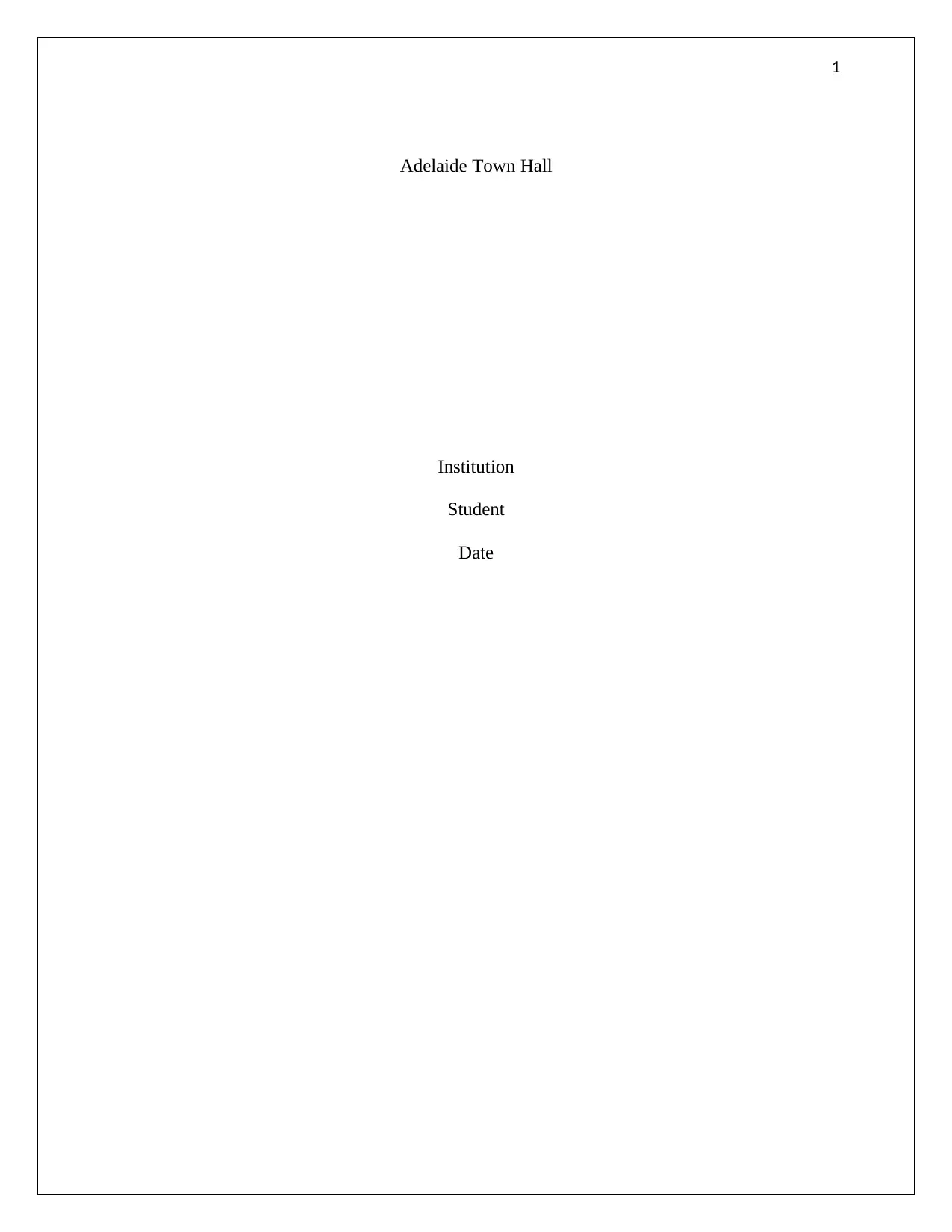
1
Adelaide Town Hall
Institution
Student
Date
Adelaide Town Hall
Institution
Student
Date
Secure Best Marks with AI Grader
Need help grading? Try our AI Grader for instant feedback on your assignments.
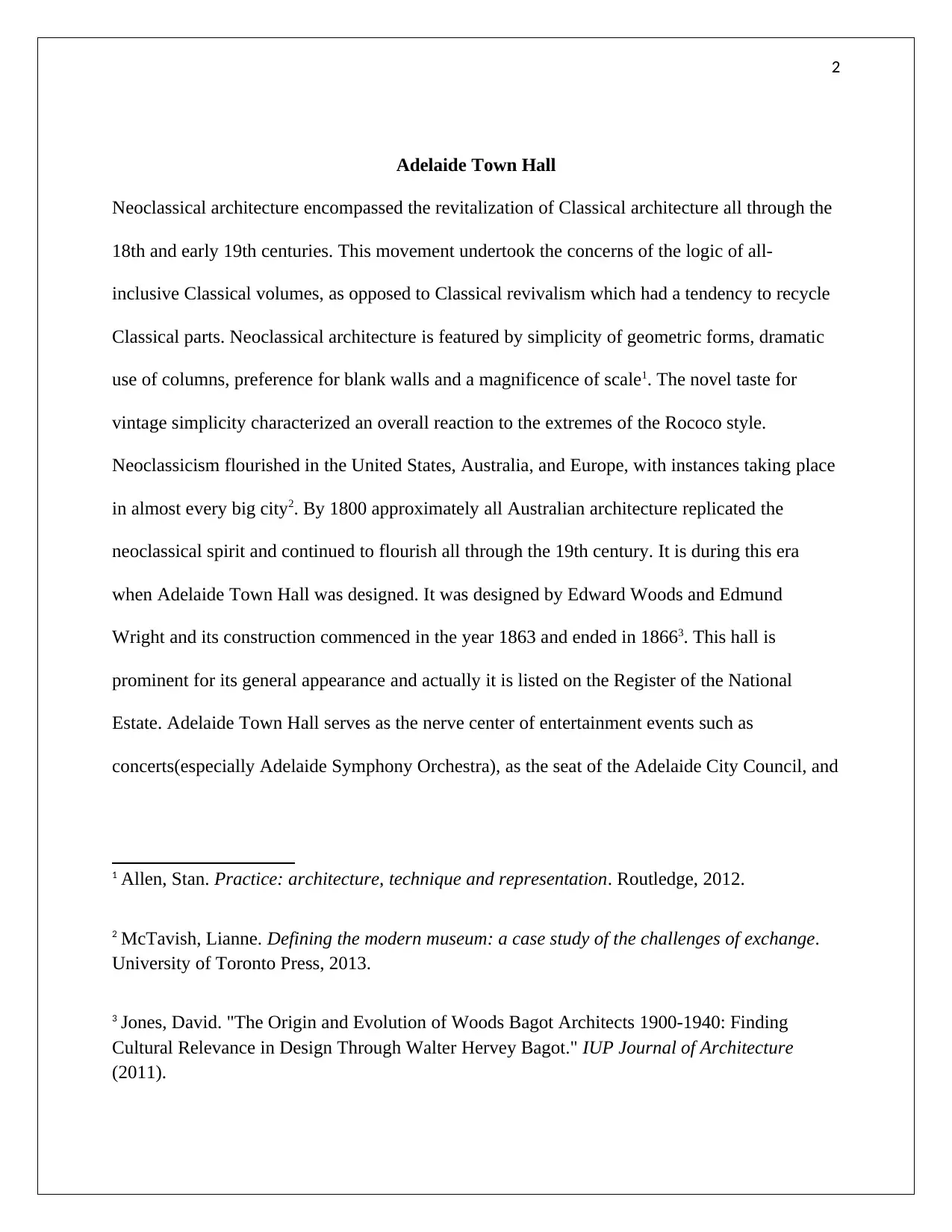
2
Adelaide Town Hall
Neoclassical architecture encompassed the revitalization of Classical architecture all through the
18th and early 19th centuries. This movement undertook the concerns of the logic of all-
inclusive Classical volumes, as opposed to Classical revivalism which had a tendency to recycle
Classical parts. Neoclassical architecture is featured by simplicity of geometric forms, dramatic
use of columns, preference for blank walls and a magnificence of scale1. The novel taste for
vintage simplicity characterized an overall reaction to the extremes of the Rococo style.
Neoclassicism flourished in the United States, Australia, and Europe, with instances taking place
in almost every big city2. By 1800 approximately all Australian architecture replicated the
neoclassical spirit and continued to flourish all through the 19th century. It is during this era
when Adelaide Town Hall was designed. It was designed by Edward Woods and Edmund
Wright and its construction commenced in the year 1863 and ended in 18663. This hall is
prominent for its general appearance and actually it is listed on the Register of the National
Estate. Adelaide Town Hall serves as the nerve center of entertainment events such as
concerts(especially Adelaide Symphony Orchestra), as the seat of the Adelaide City Council, and
1 Allen, Stan. Practice: architecture, technique and representation. Routledge, 2012.
2 McTavish, Lianne. Defining the modern museum: a case study of the challenges of exchange.
University of Toronto Press, 2013.
3 Jones, David. "The Origin and Evolution of Woods Bagot Architects 1900-1940: Finding
Cultural Relevance in Design Through Walter Hervey Bagot." IUP Journal of Architecture
(2011).
Adelaide Town Hall
Neoclassical architecture encompassed the revitalization of Classical architecture all through the
18th and early 19th centuries. This movement undertook the concerns of the logic of all-
inclusive Classical volumes, as opposed to Classical revivalism which had a tendency to recycle
Classical parts. Neoclassical architecture is featured by simplicity of geometric forms, dramatic
use of columns, preference for blank walls and a magnificence of scale1. The novel taste for
vintage simplicity characterized an overall reaction to the extremes of the Rococo style.
Neoclassicism flourished in the United States, Australia, and Europe, with instances taking place
in almost every big city2. By 1800 approximately all Australian architecture replicated the
neoclassical spirit and continued to flourish all through the 19th century. It is during this era
when Adelaide Town Hall was designed. It was designed by Edward Woods and Edmund
Wright and its construction commenced in the year 1863 and ended in 18663. This hall is
prominent for its general appearance and actually it is listed on the Register of the National
Estate. Adelaide Town Hall serves as the nerve center of entertainment events such as
concerts(especially Adelaide Symphony Orchestra), as the seat of the Adelaide City Council, and
1 Allen, Stan. Practice: architecture, technique and representation. Routledge, 2012.
2 McTavish, Lianne. Defining the modern museum: a case study of the challenges of exchange.
University of Toronto Press, 2013.
3 Jones, David. "The Origin and Evolution of Woods Bagot Architects 1900-1940: Finding
Cultural Relevance in Design Through Walter Hervey Bagot." IUP Journal of Architecture
(2011).

3
also it contains facilities for hire4. As a place for work of art concerts, its auditory range and
sense of history have frequently been commended.
Figure 1: external appearance of Adelaide Town Hall
Orders also referred to as order of architecture, refer to any of the numerous styles of
neoclassical or classical architecture that were demarcated by the specific type of entablature and
column they used as a basic unit5. In these buildings a column consisted of a chute alongside its
base and its capital. This column supported a segment of an entablature that constituted the upper
4 Collins, Julie. "Climate discourse and the architectural style debates on Adelaide’s nineteenth-
century public buildings." History Australia 12, no. 2 (2015): 188-208.
5 Barletta, Barbara A. The origins of the Greek architectural orders. Cambridge, New York:
Cambridge University Press, 2001.
also it contains facilities for hire4. As a place for work of art concerts, its auditory range and
sense of history have frequently been commended.
Figure 1: external appearance of Adelaide Town Hall
Orders also referred to as order of architecture, refer to any of the numerous styles of
neoclassical or classical architecture that were demarcated by the specific type of entablature and
column they used as a basic unit5. In these buildings a column consisted of a chute alongside its
base and its capital. This column supported a segment of an entablature that constituted the upper
4 Collins, Julie. "Climate discourse and the architectural style debates on Adelaide’s nineteenth-
century public buildings." History Australia 12, no. 2 (2015): 188-208.
5 Barletta, Barbara A. The origins of the Greek architectural orders. Cambridge, New York:
Cambridge University Press, 2001.
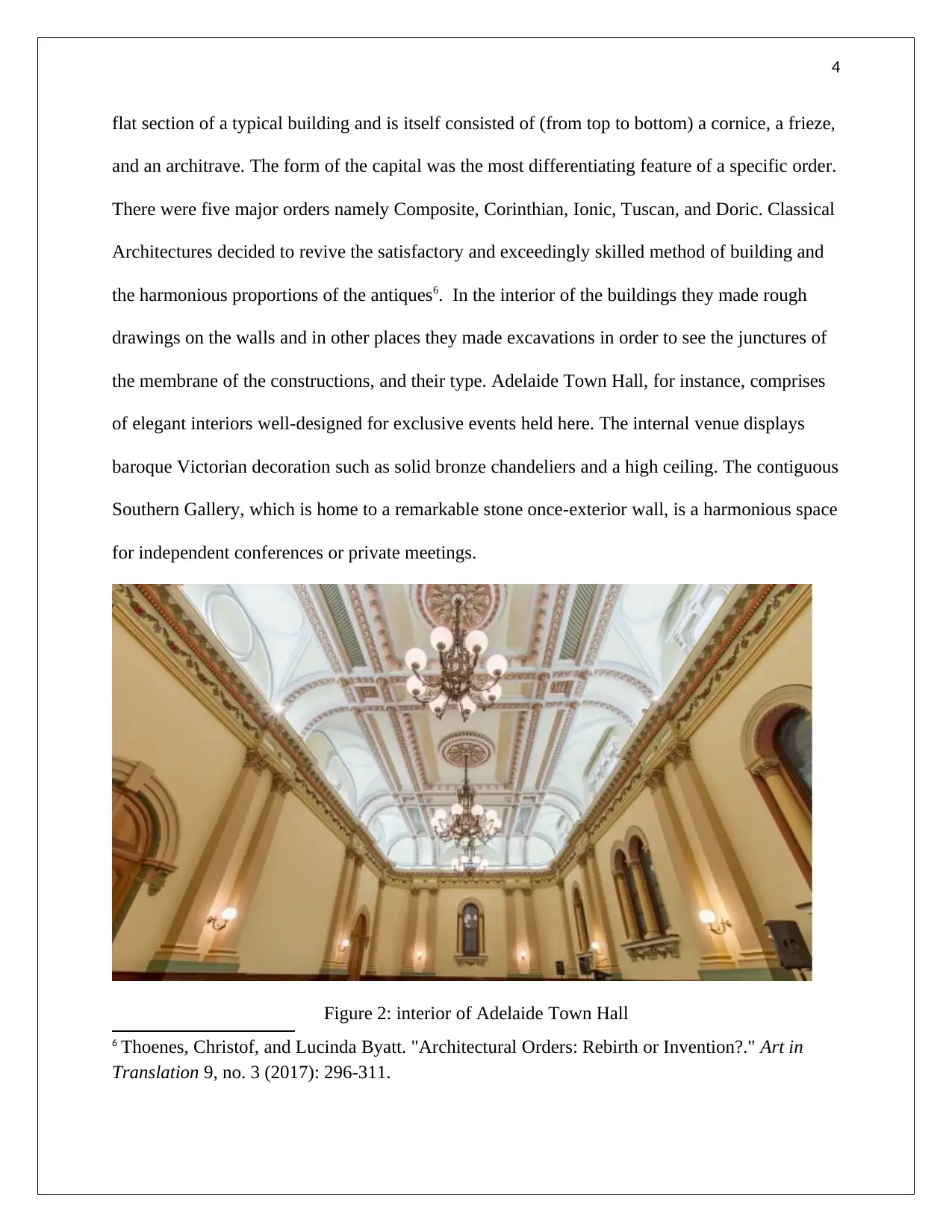
4
flat section of a typical building and is itself consisted of (from top to bottom) a cornice, a frieze,
and an architrave. The form of the capital was the most differentiating feature of a specific order.
There were five major orders namely Composite, Corinthian, Ionic, Tuscan, and Doric. Classical
Architectures decided to revive the satisfactory and exceedingly skilled method of building and
the harmonious proportions of the antiques6. In the interior of the buildings they made rough
drawings on the walls and in other places they made excavations in order to see the junctures of
the membrane of the constructions, and their type. Adelaide Town Hall, for instance, comprises
of elegant interiors well-designed for exclusive events held here. The internal venue displays
baroque Victorian decoration such as solid bronze chandeliers and a high ceiling. The contiguous
Southern Gallery, which is home to a remarkable stone once-exterior wall, is a harmonious space
for independent conferences or private meetings.
Figure 2: interior of Adelaide Town Hall
6 Thoenes, Christof, and Lucinda Byatt. "Architectural Orders: Rebirth or Invention?." Art in
Translation 9, no. 3 (2017): 296-311.
flat section of a typical building and is itself consisted of (from top to bottom) a cornice, a frieze,
and an architrave. The form of the capital was the most differentiating feature of a specific order.
There were five major orders namely Composite, Corinthian, Ionic, Tuscan, and Doric. Classical
Architectures decided to revive the satisfactory and exceedingly skilled method of building and
the harmonious proportions of the antiques6. In the interior of the buildings they made rough
drawings on the walls and in other places they made excavations in order to see the junctures of
the membrane of the constructions, and their type. Adelaide Town Hall, for instance, comprises
of elegant interiors well-designed for exclusive events held here. The internal venue displays
baroque Victorian decoration such as solid bronze chandeliers and a high ceiling. The contiguous
Southern Gallery, which is home to a remarkable stone once-exterior wall, is a harmonious space
for independent conferences or private meetings.
Figure 2: interior of Adelaide Town Hall
6 Thoenes, Christof, and Lucinda Byatt. "Architectural Orders: Rebirth or Invention?." Art in
Translation 9, no. 3 (2017): 296-311.
Secure Best Marks with AI Grader
Need help grading? Try our AI Grader for instant feedback on your assignments.
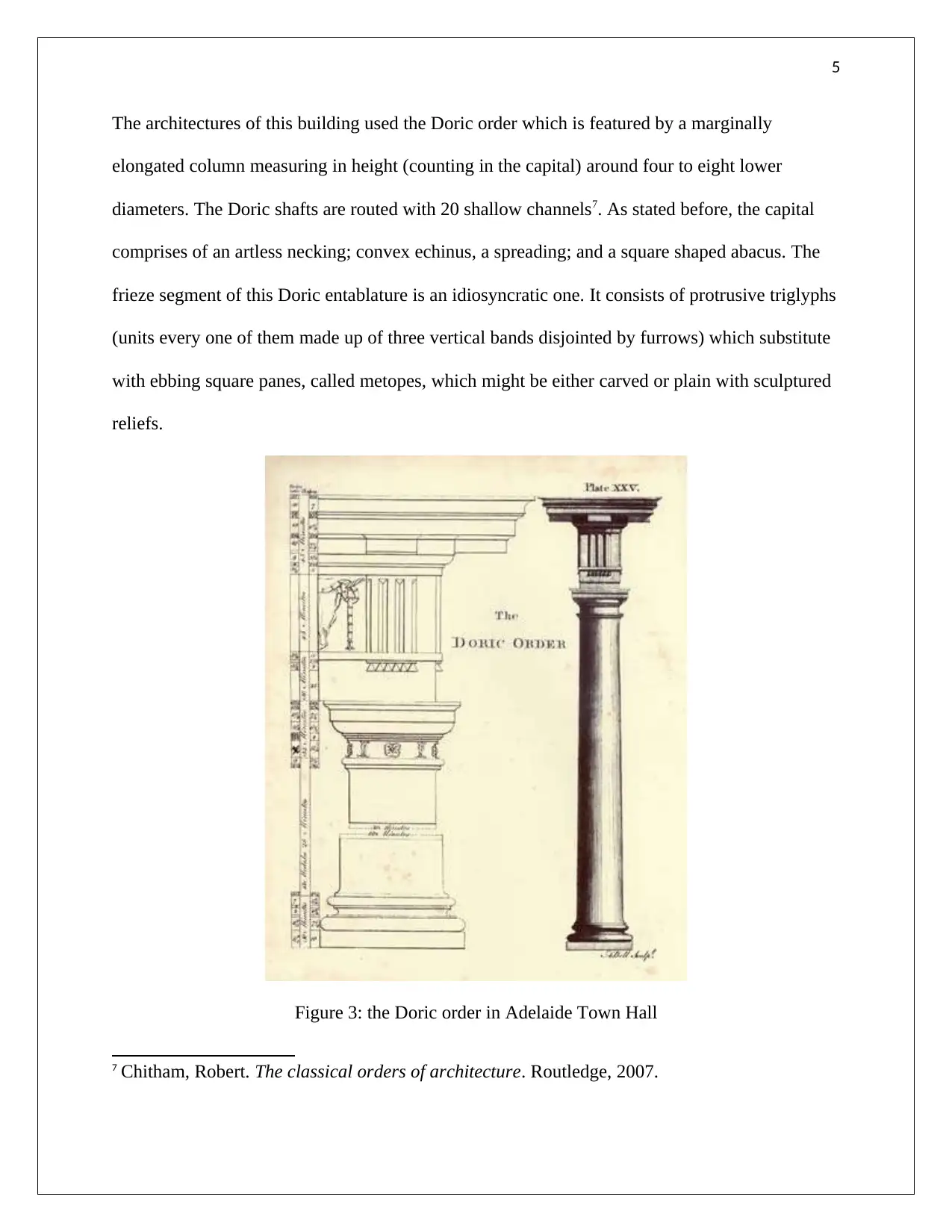
5
The architectures of this building used the Doric order which is featured by a marginally
elongated column measuring in height (counting in the capital) around four to eight lower
diameters. The Doric shafts are routed with 20 shallow channels7. As stated before, the capital
comprises of an artless necking; convex echinus, a spreading; and a square shaped abacus. The
frieze segment of this Doric entablature is an idiosyncratic one. It consists of protrusive triglyphs
(units every one of them made up of three vertical bands disjointed by furrows) which substitute
with ebbing square panes, called metopes, which might be either carved or plain with sculptured
reliefs.
Figure 3: the Doric order in Adelaide Town Hall
7 Chitham, Robert. The classical orders of architecture. Routledge, 2007.
The architectures of this building used the Doric order which is featured by a marginally
elongated column measuring in height (counting in the capital) around four to eight lower
diameters. The Doric shafts are routed with 20 shallow channels7. As stated before, the capital
comprises of an artless necking; convex echinus, a spreading; and a square shaped abacus. The
frieze segment of this Doric entablature is an idiosyncratic one. It consists of protrusive triglyphs
(units every one of them made up of three vertical bands disjointed by furrows) which substitute
with ebbing square panes, called metopes, which might be either carved or plain with sculptured
reliefs.
Figure 3: the Doric order in Adelaide Town Hall
7 Chitham, Robert. The classical orders of architecture. Routledge, 2007.
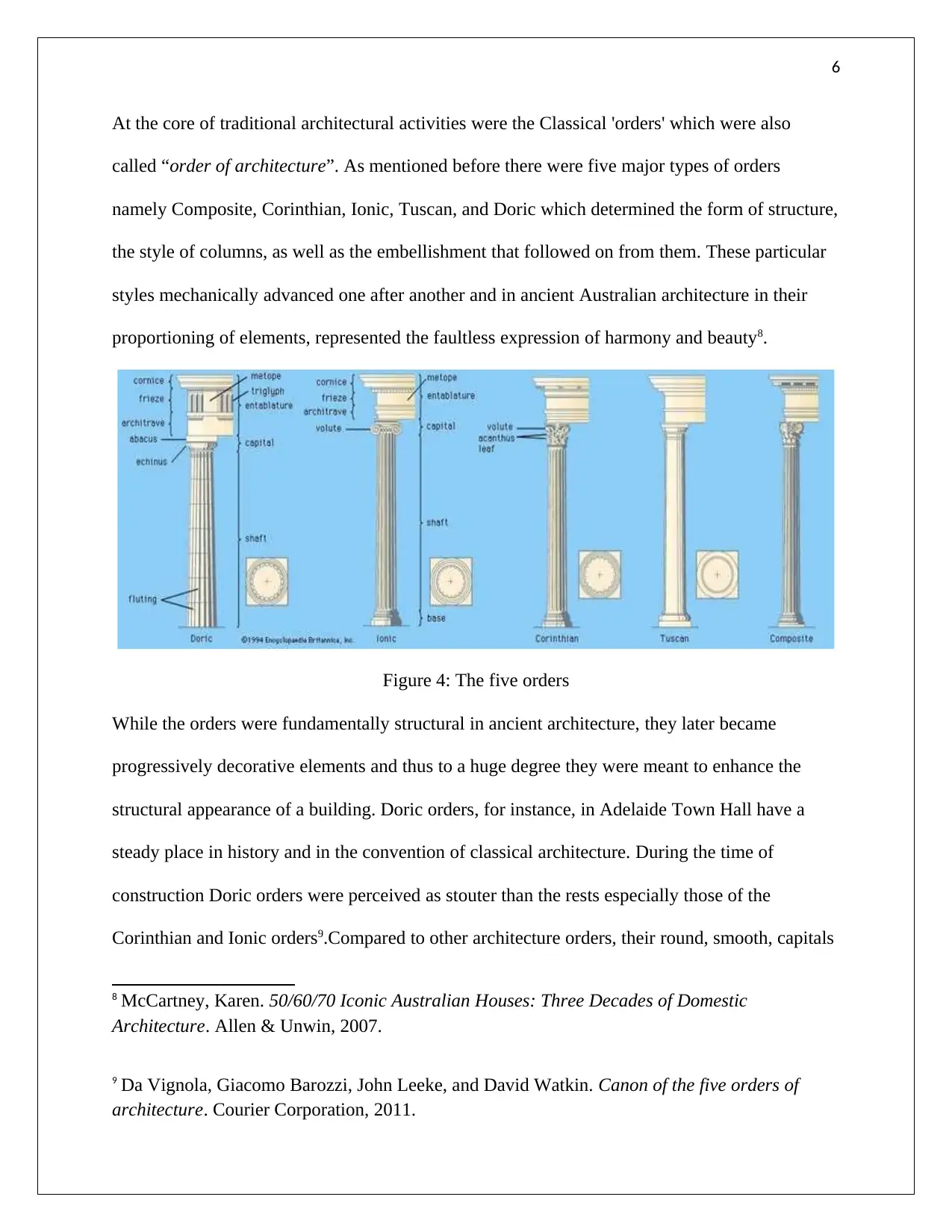
6
At the core of traditional architectural activities were the Classical 'orders' which were also
called “order of architecture”. As mentioned before there were five major types of orders
namely Composite, Corinthian, Ionic, Tuscan, and Doric which determined the form of structure,
the style of columns, as well as the embellishment that followed on from them. These particular
styles mechanically advanced one after another and in ancient Australian architecture in their
proportioning of elements, represented the faultless expression of harmony and beauty8.
Figure 4: The five orders
While the orders were fundamentally structural in ancient architecture, they later became
progressively decorative elements and thus to a huge degree they were meant to enhance the
structural appearance of a building. Doric orders, for instance, in Adelaide Town Hall have a
steady place in history and in the convention of classical architecture. During the time of
construction Doric orders were perceived as stouter than the rests especially those of the
Corinthian and Ionic orders9.Compared to other architecture orders, their round, smooth, capitals
8 McCartney, Karen. 50/60/70 Iconic Australian Houses: Three Decades of Domestic
Architecture. Allen & Unwin, 2007.
9 Da Vignola, Giacomo Barozzi, John Leeke, and David Watkin. Canon of the five orders of
architecture. Courier Corporation, 2011.
At the core of traditional architectural activities were the Classical 'orders' which were also
called “order of architecture”. As mentioned before there were five major types of orders
namely Composite, Corinthian, Ionic, Tuscan, and Doric which determined the form of structure,
the style of columns, as well as the embellishment that followed on from them. These particular
styles mechanically advanced one after another and in ancient Australian architecture in their
proportioning of elements, represented the faultless expression of harmony and beauty8.
Figure 4: The five orders
While the orders were fundamentally structural in ancient architecture, they later became
progressively decorative elements and thus to a huge degree they were meant to enhance the
structural appearance of a building. Doric orders, for instance, in Adelaide Town Hall have a
steady place in history and in the convention of classical architecture. During the time of
construction Doric orders were perceived as stouter than the rests especially those of the
Corinthian and Ionic orders9.Compared to other architecture orders, their round, smooth, capitals
8 McCartney, Karen. 50/60/70 Iconic Australian Houses: Three Decades of Domestic
Architecture. Allen & Unwin, 2007.
9 Da Vignola, Giacomo Barozzi, John Leeke, and David Watkin. Canon of the five orders of
architecture. Courier Corporation, 2011.
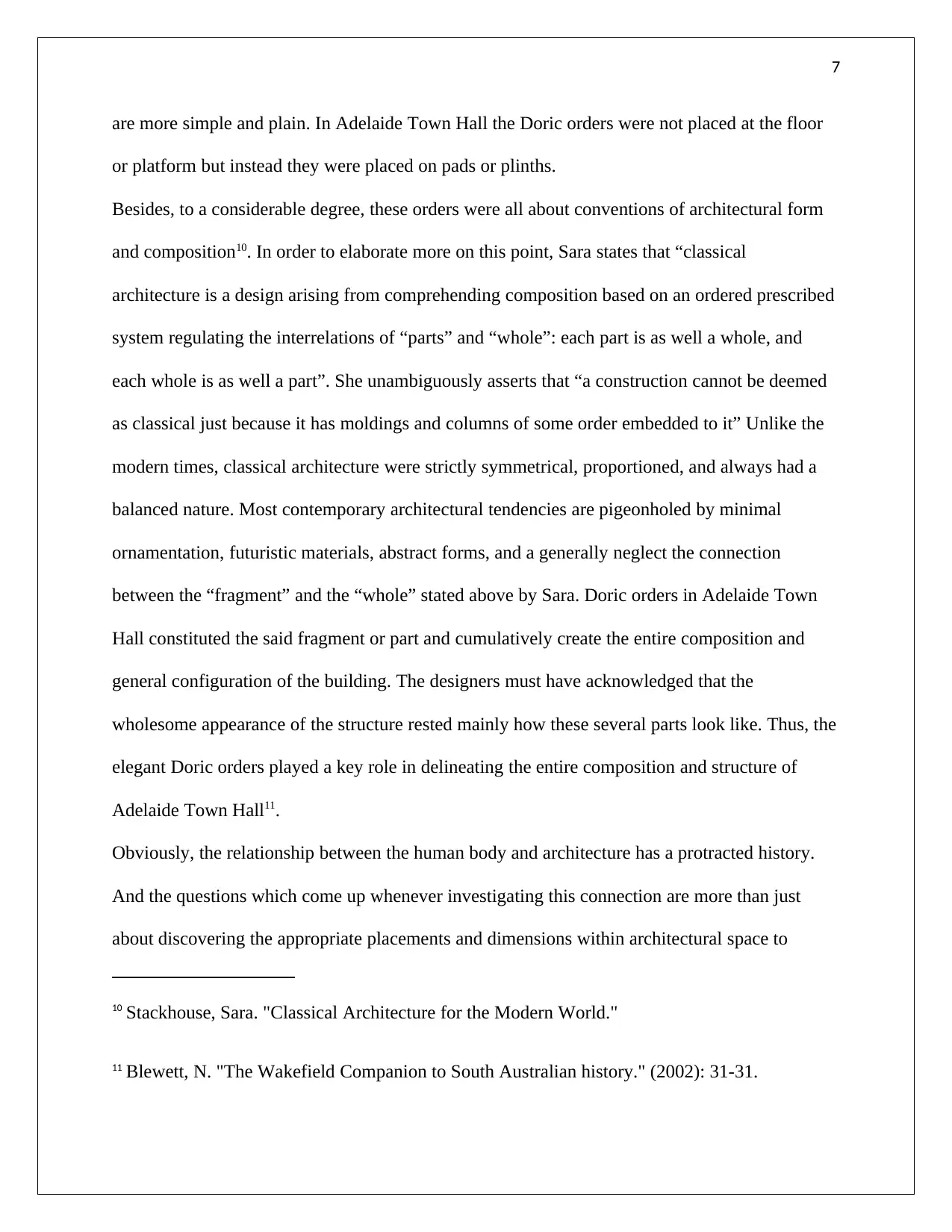
7
are more simple and plain. In Adelaide Town Hall the Doric orders were not placed at the floor
or platform but instead they were placed on pads or plinths.
Besides, to a considerable degree, these orders were all about conventions of architectural form
and composition10. In order to elaborate more on this point, Sara states that “classical
architecture is a design arising from comprehending composition based on an ordered prescribed
system regulating the interrelations of “parts” and “whole”: each part is as well a whole, and
each whole is as well a part”. She unambiguously asserts that “a construction cannot be deemed
as classical just because it has moldings and columns of some order embedded to it” Unlike the
modern times, classical architecture were strictly symmetrical, proportioned, and always had a
balanced nature. Most contemporary architectural tendencies are pigeonholed by minimal
ornamentation, futuristic materials, abstract forms, and a generally neglect the connection
between the “fragment” and the “whole” stated above by Sara. Doric orders in Adelaide Town
Hall constituted the said fragment or part and cumulatively create the entire composition and
general configuration of the building. The designers must have acknowledged that the
wholesome appearance of the structure rested mainly how these several parts look like. Thus, the
elegant Doric orders played a key role in delineating the entire composition and structure of
Adelaide Town Hall11.
Obviously, the relationship between the human body and architecture has a protracted history.
And the questions which come up whenever investigating this connection are more than just
about discovering the appropriate placements and dimensions within architectural space to
10 Stackhouse, Sara. "Classical Architecture for the Modern World."
11 Blewett, N. "The Wakefield Companion to South Australian history." (2002): 31-31.
are more simple and plain. In Adelaide Town Hall the Doric orders were not placed at the floor
or platform but instead they were placed on pads or plinths.
Besides, to a considerable degree, these orders were all about conventions of architectural form
and composition10. In order to elaborate more on this point, Sara states that “classical
architecture is a design arising from comprehending composition based on an ordered prescribed
system regulating the interrelations of “parts” and “whole”: each part is as well a whole, and
each whole is as well a part”. She unambiguously asserts that “a construction cannot be deemed
as classical just because it has moldings and columns of some order embedded to it” Unlike the
modern times, classical architecture were strictly symmetrical, proportioned, and always had a
balanced nature. Most contemporary architectural tendencies are pigeonholed by minimal
ornamentation, futuristic materials, abstract forms, and a generally neglect the connection
between the “fragment” and the “whole” stated above by Sara. Doric orders in Adelaide Town
Hall constituted the said fragment or part and cumulatively create the entire composition and
general configuration of the building. The designers must have acknowledged that the
wholesome appearance of the structure rested mainly how these several parts look like. Thus, the
elegant Doric orders played a key role in delineating the entire composition and structure of
Adelaide Town Hall11.
Obviously, the relationship between the human body and architecture has a protracted history.
And the questions which come up whenever investigating this connection are more than just
about discovering the appropriate placements and dimensions within architectural space to
10 Stackhouse, Sara. "Classical Architecture for the Modern World."
11 Blewett, N. "The Wakefield Companion to South Australian history." (2002): 31-31.
Paraphrase This Document
Need a fresh take? Get an instant paraphrase of this document with our AI Paraphraser
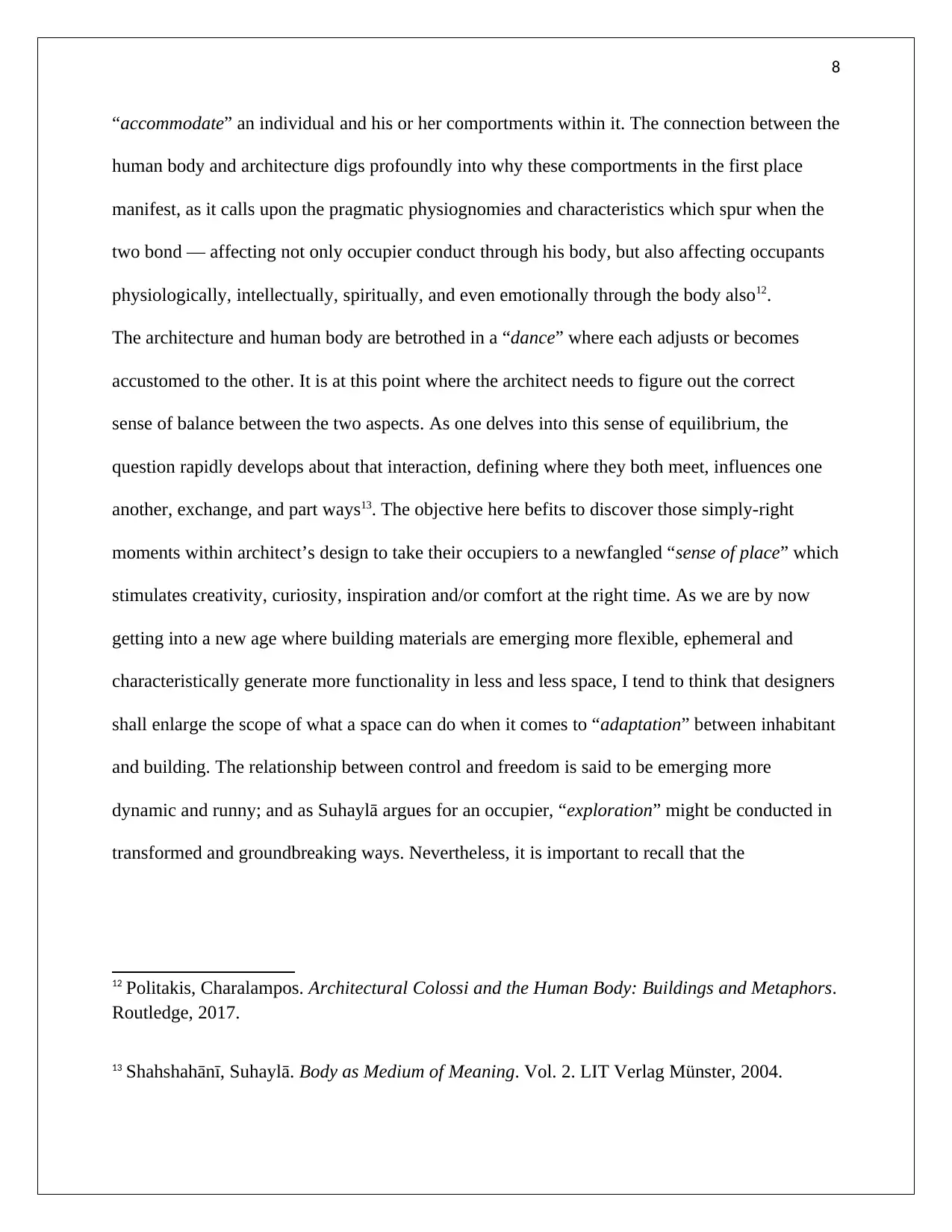
8
“accommodate” an individual and his or her comportments within it. The connection between the
human body and architecture digs profoundly into why these comportments in the first place
manifest, as it calls upon the pragmatic physiognomies and characteristics which spur when the
two bond — affecting not only occupier conduct through his body, but also affecting occupants
physiologically, intellectually, spiritually, and even emotionally through the body also12.
The architecture and human body are betrothed in a “dance” where each adjusts or becomes
accustomed to the other. It is at this point where the architect needs to figure out the correct
sense of balance between the two aspects. As one delves into this sense of equilibrium, the
question rapidly develops about that interaction, defining where they both meet, influences one
another, exchange, and part ways13. The objective here befits to discover those simply-right
moments within architect’s design to take their occupiers to a newfangled “sense of place” which
stimulates creativity, curiosity, inspiration and/or comfort at the right time. As we are by now
getting into a new age where building materials are emerging more flexible, ephemeral and
characteristically generate more functionality in less and less space, I tend to think that designers
shall enlarge the scope of what a space can do when it comes to “adaptation” between inhabitant
and building. The relationship between control and freedom is said to be emerging more
dynamic and runny; and as Suhaylā argues for an occupier, “exploration” might be conducted in
transformed and groundbreaking ways. Nevertheless, it is important to recall that the
12 Politakis, Charalampos. Architectural Colossi and the Human Body: Buildings and Metaphors.
Routledge, 2017.
13 Shahshahānī, Suhaylā. Body as Medium of Meaning. Vol. 2. LIT Verlag Münster, 2004.
“accommodate” an individual and his or her comportments within it. The connection between the
human body and architecture digs profoundly into why these comportments in the first place
manifest, as it calls upon the pragmatic physiognomies and characteristics which spur when the
two bond — affecting not only occupier conduct through his body, but also affecting occupants
physiologically, intellectually, spiritually, and even emotionally through the body also12.
The architecture and human body are betrothed in a “dance” where each adjusts or becomes
accustomed to the other. It is at this point where the architect needs to figure out the correct
sense of balance between the two aspects. As one delves into this sense of equilibrium, the
question rapidly develops about that interaction, defining where they both meet, influences one
another, exchange, and part ways13. The objective here befits to discover those simply-right
moments within architect’s design to take their occupiers to a newfangled “sense of place” which
stimulates creativity, curiosity, inspiration and/or comfort at the right time. As we are by now
getting into a new age where building materials are emerging more flexible, ephemeral and
characteristically generate more functionality in less and less space, I tend to think that designers
shall enlarge the scope of what a space can do when it comes to “adaptation” between inhabitant
and building. The relationship between control and freedom is said to be emerging more
dynamic and runny; and as Suhaylā argues for an occupier, “exploration” might be conducted in
transformed and groundbreaking ways. Nevertheless, it is important to recall that the
12 Politakis, Charalampos. Architectural Colossi and the Human Body: Buildings and Metaphors.
Routledge, 2017.
13 Shahshahānī, Suhaylā. Body as Medium of Meaning. Vol. 2. LIT Verlag Münster, 2004.
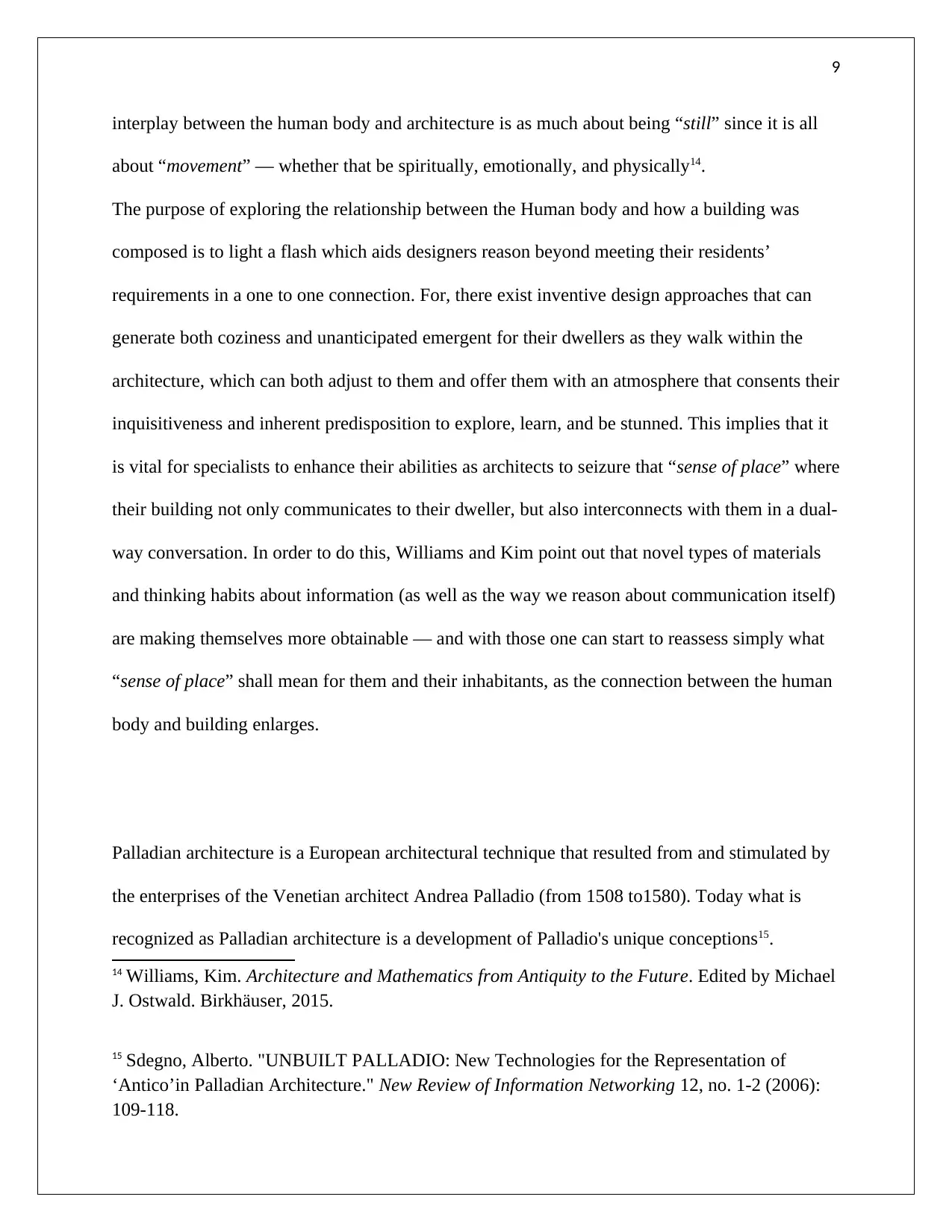
9
interplay between the human body and architecture is as much about being “still” since it is all
about “movement” — whether that be spiritually, emotionally, and physically14.
The purpose of exploring the relationship between the Human body and how a building was
composed is to light a flash which aids designers reason beyond meeting their residents’
requirements in a one to one connection. For, there exist inventive design approaches that can
generate both coziness and unanticipated emergent for their dwellers as they walk within the
architecture, which can both adjust to them and offer them with an atmosphere that consents their
inquisitiveness and inherent predisposition to explore, learn, and be stunned. This implies that it
is vital for specialists to enhance their abilities as architects to seizure that “sense of place” where
their building not only communicates to their dweller, but also interconnects with them in a dual-
way conversation. In order to do this, Williams and Kim point out that novel types of materials
and thinking habits about information (as well as the way we reason about communication itself)
are making themselves more obtainable — and with those one can start to reassess simply what
“sense of place” shall mean for them and their inhabitants, as the connection between the human
body and building enlarges.
Palladian architecture is a European architectural technique that resulted from and stimulated by
the enterprises of the Venetian architect Andrea Palladio (from 1508 to1580). Today what is
recognized as Palladian architecture is a development of Palladio's unique conceptions15.
14 Williams, Kim. Architecture and Mathematics from Antiquity to the Future. Edited by Michael
J. Ostwald. Birkhäuser, 2015.
15 Sdegno, Alberto. "UNBUILT PALLADIO: New Technologies for the Representation of
‘Antico’in Palladian Architecture." New Review of Information Networking 12, no. 1-2 (2006):
109-118.
interplay between the human body and architecture is as much about being “still” since it is all
about “movement” — whether that be spiritually, emotionally, and physically14.
The purpose of exploring the relationship between the Human body and how a building was
composed is to light a flash which aids designers reason beyond meeting their residents’
requirements in a one to one connection. For, there exist inventive design approaches that can
generate both coziness and unanticipated emergent for their dwellers as they walk within the
architecture, which can both adjust to them and offer them with an atmosphere that consents their
inquisitiveness and inherent predisposition to explore, learn, and be stunned. This implies that it
is vital for specialists to enhance their abilities as architects to seizure that “sense of place” where
their building not only communicates to their dweller, but also interconnects with them in a dual-
way conversation. In order to do this, Williams and Kim point out that novel types of materials
and thinking habits about information (as well as the way we reason about communication itself)
are making themselves more obtainable — and with those one can start to reassess simply what
“sense of place” shall mean for them and their inhabitants, as the connection between the human
body and building enlarges.
Palladian architecture is a European architectural technique that resulted from and stimulated by
the enterprises of the Venetian architect Andrea Palladio (from 1508 to1580). Today what is
recognized as Palladian architecture is a development of Palladio's unique conceptions15.
14 Williams, Kim. Architecture and Mathematics from Antiquity to the Future. Edited by Michael
J. Ostwald. Birkhäuser, 2015.
15 Sdegno, Alberto. "UNBUILT PALLADIO: New Technologies for the Representation of
‘Antico’in Palladian Architecture." New Review of Information Networking 12, no. 1-2 (2006):
109-118.
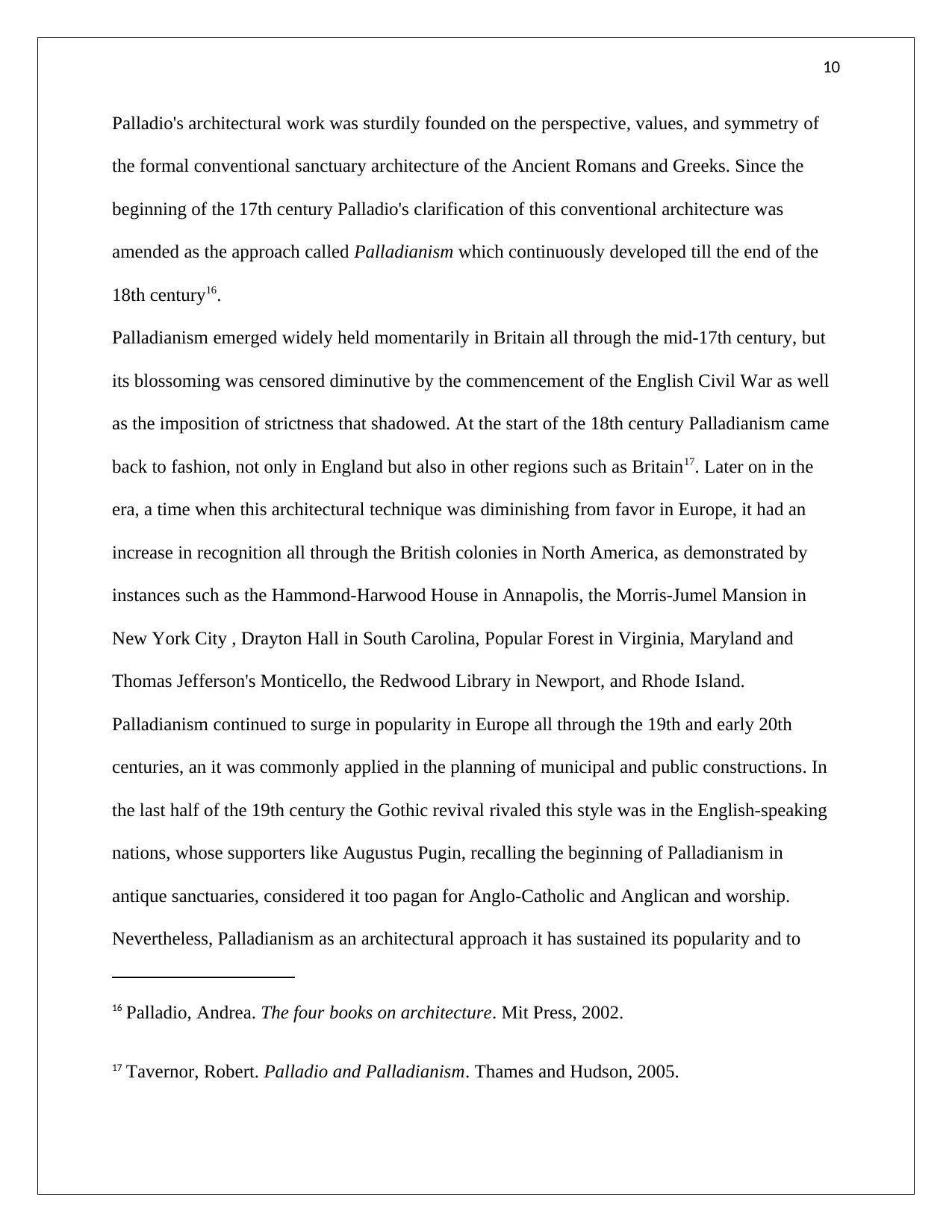
10
Palladio's architectural work was sturdily founded on the perspective, values, and symmetry of
the formal conventional sanctuary architecture of the Ancient Romans and Greeks. Since the
beginning of the 17th century Palladio's clarification of this conventional architecture was
amended as the approach called Palladianism which continuously developed till the end of the
18th century16.
Palladianism emerged widely held momentarily in Britain all through the mid-17th century, but
its blossoming was censored diminutive by the commencement of the English Civil War as well
as the imposition of strictness that shadowed. At the start of the 18th century Palladianism came
back to fashion, not only in England but also in other regions such as Britain17. Later on in the
era, a time when this architectural technique was diminishing from favor in Europe, it had an
increase in recognition all through the British colonies in North America, as demonstrated by
instances such as the Hammond-Harwood House in Annapolis, the Morris-Jumel Mansion in
New York City , Drayton Hall in South Carolina, Popular Forest in Virginia, Maryland and
Thomas Jefferson's Monticello, the Redwood Library in Newport, and Rhode Island.
Palladianism continued to surge in popularity in Europe all through the 19th and early 20th
centuries, an it was commonly applied in the planning of municipal and public constructions. In
the last half of the 19th century the Gothic revival rivaled this style was in the English-speaking
nations, whose supporters like Augustus Pugin, recalling the beginning of Palladianism in
antique sanctuaries, considered it too pagan for Anglo-Catholic and Anglican and worship.
Nevertheless, Palladianism as an architectural approach it has sustained its popularity and to
16 Palladio, Andrea. The four books on architecture. Mit Press, 2002.
17 Tavernor, Robert. Palladio and Palladianism. Thames and Hudson, 2005.
Palladio's architectural work was sturdily founded on the perspective, values, and symmetry of
the formal conventional sanctuary architecture of the Ancient Romans and Greeks. Since the
beginning of the 17th century Palladio's clarification of this conventional architecture was
amended as the approach called Palladianism which continuously developed till the end of the
18th century16.
Palladianism emerged widely held momentarily in Britain all through the mid-17th century, but
its blossoming was censored diminutive by the commencement of the English Civil War as well
as the imposition of strictness that shadowed. At the start of the 18th century Palladianism came
back to fashion, not only in England but also in other regions such as Britain17. Later on in the
era, a time when this architectural technique was diminishing from favor in Europe, it had an
increase in recognition all through the British colonies in North America, as demonstrated by
instances such as the Hammond-Harwood House in Annapolis, the Morris-Jumel Mansion in
New York City , Drayton Hall in South Carolina, Popular Forest in Virginia, Maryland and
Thomas Jefferson's Monticello, the Redwood Library in Newport, and Rhode Island.
Palladianism continued to surge in popularity in Europe all through the 19th and early 20th
centuries, an it was commonly applied in the planning of municipal and public constructions. In
the last half of the 19th century the Gothic revival rivaled this style was in the English-speaking
nations, whose supporters like Augustus Pugin, recalling the beginning of Palladianism in
antique sanctuaries, considered it too pagan for Anglo-Catholic and Anglican and worship.
Nevertheless, Palladianism as an architectural approach it has sustained its popularity and to
16 Palladio, Andrea. The four books on architecture. Mit Press, 2002.
17 Tavernor, Robert. Palladio and Palladianism. Thames and Hudson, 2005.
Secure Best Marks with AI Grader
Need help grading? Try our AI Grader for instant feedback on your assignments.
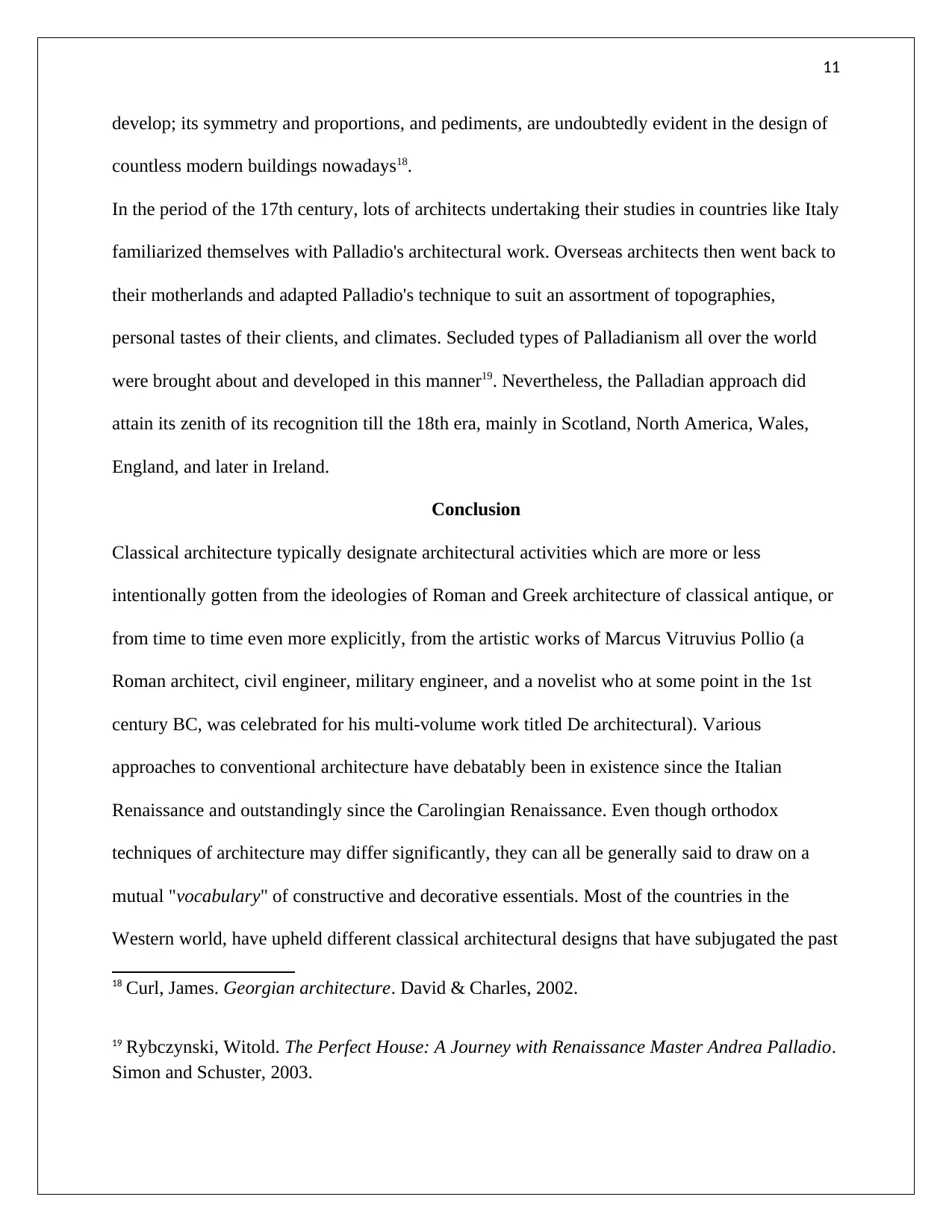
11
develop; its symmetry and proportions, and pediments, are undoubtedly evident in the design of
countless modern buildings nowadays18.
In the period of the 17th century, lots of architects undertaking their studies in countries like Italy
familiarized themselves with Palladio's architectural work. Overseas architects then went back to
their motherlands and adapted Palladio's technique to suit an assortment of topographies,
personal tastes of their clients, and climates. Secluded types of Palladianism all over the world
were brought about and developed in this manner19. Nevertheless, the Palladian approach did
attain its zenith of its recognition till the 18th era, mainly in Scotland, North America, Wales,
England, and later in Ireland.
Conclusion
Classical architecture typically designate architectural activities which are more or less
intentionally gotten from the ideologies of Roman and Greek architecture of classical antique, or
from time to time even more explicitly, from the artistic works of Marcus Vitruvius Pollio (a
Roman architect, civil engineer, military engineer, and a novelist who at some point in the 1st
century BC, was celebrated for his multi-volume work titled De architectural). Various
approaches to conventional architecture have debatably been in existence since the Italian
Renaissance and outstandingly since the Carolingian Renaissance. Even though orthodox
techniques of architecture may differ significantly, they can all be generally said to draw on a
mutual "vocabulary" of constructive and decorative essentials. Most of the countries in the
Western world, have upheld different classical architectural designs that have subjugated the past
18 Curl, James. Georgian architecture. David & Charles, 2002.
19 Rybczynski, Witold. The Perfect House: A Journey with Renaissance Master Andrea Palladio.
Simon and Schuster, 2003.
develop; its symmetry and proportions, and pediments, are undoubtedly evident in the design of
countless modern buildings nowadays18.
In the period of the 17th century, lots of architects undertaking their studies in countries like Italy
familiarized themselves with Palladio's architectural work. Overseas architects then went back to
their motherlands and adapted Palladio's technique to suit an assortment of topographies,
personal tastes of their clients, and climates. Secluded types of Palladianism all over the world
were brought about and developed in this manner19. Nevertheless, the Palladian approach did
attain its zenith of its recognition till the 18th era, mainly in Scotland, North America, Wales,
England, and later in Ireland.
Conclusion
Classical architecture typically designate architectural activities which are more or less
intentionally gotten from the ideologies of Roman and Greek architecture of classical antique, or
from time to time even more explicitly, from the artistic works of Marcus Vitruvius Pollio (a
Roman architect, civil engineer, military engineer, and a novelist who at some point in the 1st
century BC, was celebrated for his multi-volume work titled De architectural). Various
approaches to conventional architecture have debatably been in existence since the Italian
Renaissance and outstandingly since the Carolingian Renaissance. Even though orthodox
techniques of architecture may differ significantly, they can all be generally said to draw on a
mutual "vocabulary" of constructive and decorative essentials. Most of the countries in the
Western world, have upheld different classical architectural designs that have subjugated the past
18 Curl, James. Georgian architecture. David & Charles, 2002.
19 Rybczynski, Witold. The Perfect House: A Journey with Renaissance Master Andrea Palladio.
Simon and Schuster, 2003.
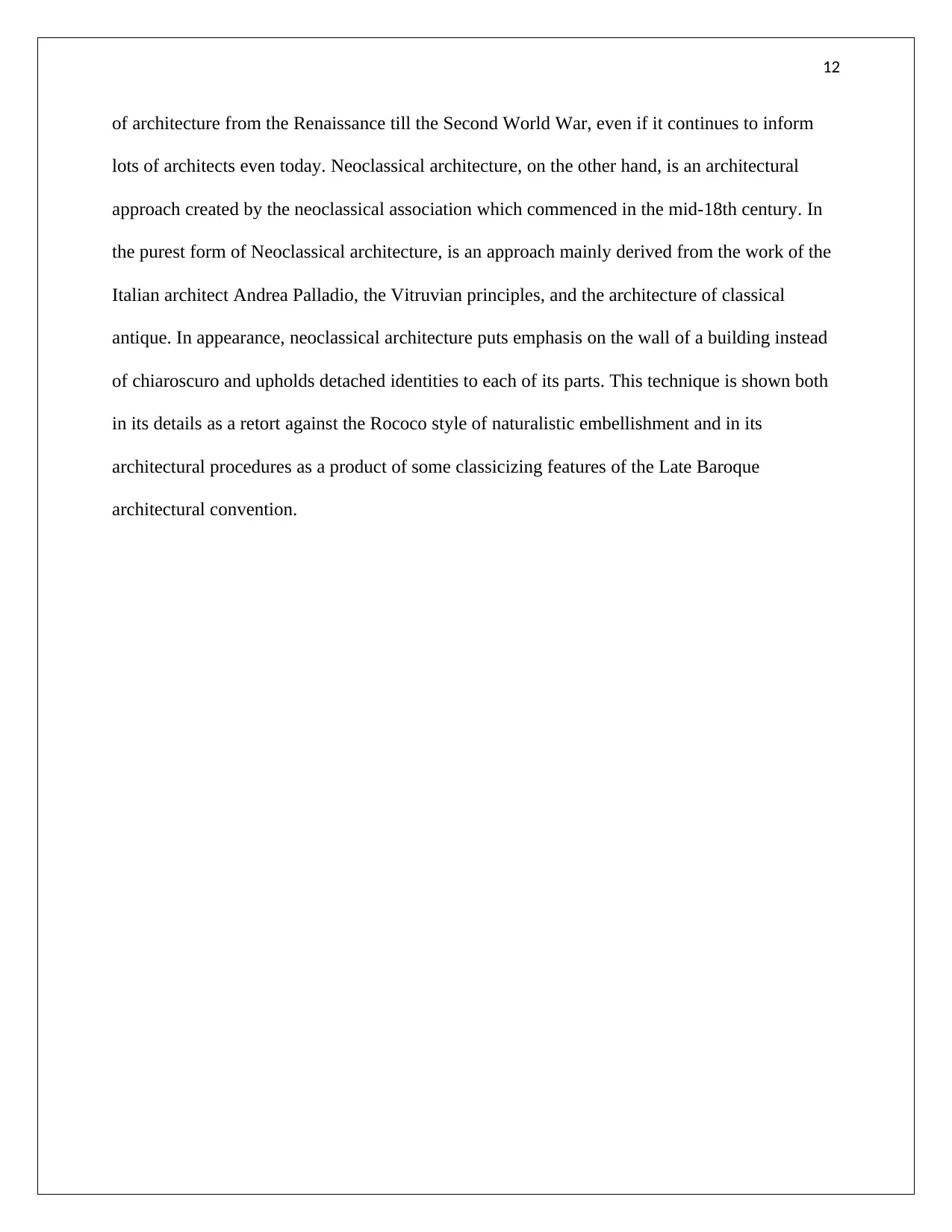
12
of architecture from the Renaissance till the Second World War, even if it continues to inform
lots of architects even today. Neoclassical architecture, on the other hand, is an architectural
approach created by the neoclassical association which commenced in the mid-18th century. In
the purest form of Neoclassical architecture, is an approach mainly derived from the work of the
Italian architect Andrea Palladio, the Vitruvian principles, and the architecture of classical
antique. In appearance, neoclassical architecture puts emphasis on the wall of a building instead
of chiaroscuro and upholds detached identities to each of its parts. This technique is shown both
in its details as a retort against the Rococo style of naturalistic embellishment and in its
architectural procedures as a product of some classicizing features of the Late Baroque
architectural convention.
of architecture from the Renaissance till the Second World War, even if it continues to inform
lots of architects even today. Neoclassical architecture, on the other hand, is an architectural
approach created by the neoclassical association which commenced in the mid-18th century. In
the purest form of Neoclassical architecture, is an approach mainly derived from the work of the
Italian architect Andrea Palladio, the Vitruvian principles, and the architecture of classical
antique. In appearance, neoclassical architecture puts emphasis on the wall of a building instead
of chiaroscuro and upholds detached identities to each of its parts. This technique is shown both
in its details as a retort against the Rococo style of naturalistic embellishment and in its
architectural procedures as a product of some classicizing features of the Late Baroque
architectural convention.

13
Bibliography
Chitham, Robert. The classical orders of architecture. Routledge, 2007.
Thoenes, Christof, and Lucinda Byatt. "Architectural Orders: Rebirth or Invention?." Art in
Translation 9, no. 3 (2017): 296-311.
Allen, Stan. Practice: architecture, technique and representation. Routledge, 2012.
Barletta, Barbara A. The origins of the Greek architectural orders. Cambridge, New York:
Cambridge University Press, 2001.
Blewett, N. "The Wakefield Companion to South Australian history." (2002): 31-31.
Collins, Julie. "Climate discourse and the architectural style debates on Adelaide’s nineteenth-
century public buildings." History Australia 12, no. 2 (2015): 188-208.
Curl, James. Georgian architecture. David & Charles, 2002.
Da Vignola, Giacomo Barozzi, John Leeke, and David Watkin. Canon of the five orders of
architecture. Courier Corporation, 2011.
Jones, David. "The Origin and Evolution of Woods Bagot Architects 1900-1940: Finding
Cultural Relevance in Design Through Walter Hervey Bagot." IUP Journal of
Architecture (2011).
McCartney, Karen. 50/60/70 Iconic Australian Houses: Three Decades of Domestic
Architecture. Allen & Unwin, 2007.
McTavish, Lianne. Defining the modern museum: a case study of the challenges of exchange.
University of Toronto Press, 2013.
Palladio, Andrea. The four books on architecture. Mit Press, 2002.
Bibliography
Chitham, Robert. The classical orders of architecture. Routledge, 2007.
Thoenes, Christof, and Lucinda Byatt. "Architectural Orders: Rebirth or Invention?." Art in
Translation 9, no. 3 (2017): 296-311.
Allen, Stan. Practice: architecture, technique and representation. Routledge, 2012.
Barletta, Barbara A. The origins of the Greek architectural orders. Cambridge, New York:
Cambridge University Press, 2001.
Blewett, N. "The Wakefield Companion to South Australian history." (2002): 31-31.
Collins, Julie. "Climate discourse and the architectural style debates on Adelaide’s nineteenth-
century public buildings." History Australia 12, no. 2 (2015): 188-208.
Curl, James. Georgian architecture. David & Charles, 2002.
Da Vignola, Giacomo Barozzi, John Leeke, and David Watkin. Canon of the five orders of
architecture. Courier Corporation, 2011.
Jones, David. "The Origin and Evolution of Woods Bagot Architects 1900-1940: Finding
Cultural Relevance in Design Through Walter Hervey Bagot." IUP Journal of
Architecture (2011).
McCartney, Karen. 50/60/70 Iconic Australian Houses: Three Decades of Domestic
Architecture. Allen & Unwin, 2007.
McTavish, Lianne. Defining the modern museum: a case study of the challenges of exchange.
University of Toronto Press, 2013.
Palladio, Andrea. The four books on architecture. Mit Press, 2002.
Paraphrase This Document
Need a fresh take? Get an instant paraphrase of this document with our AI Paraphraser
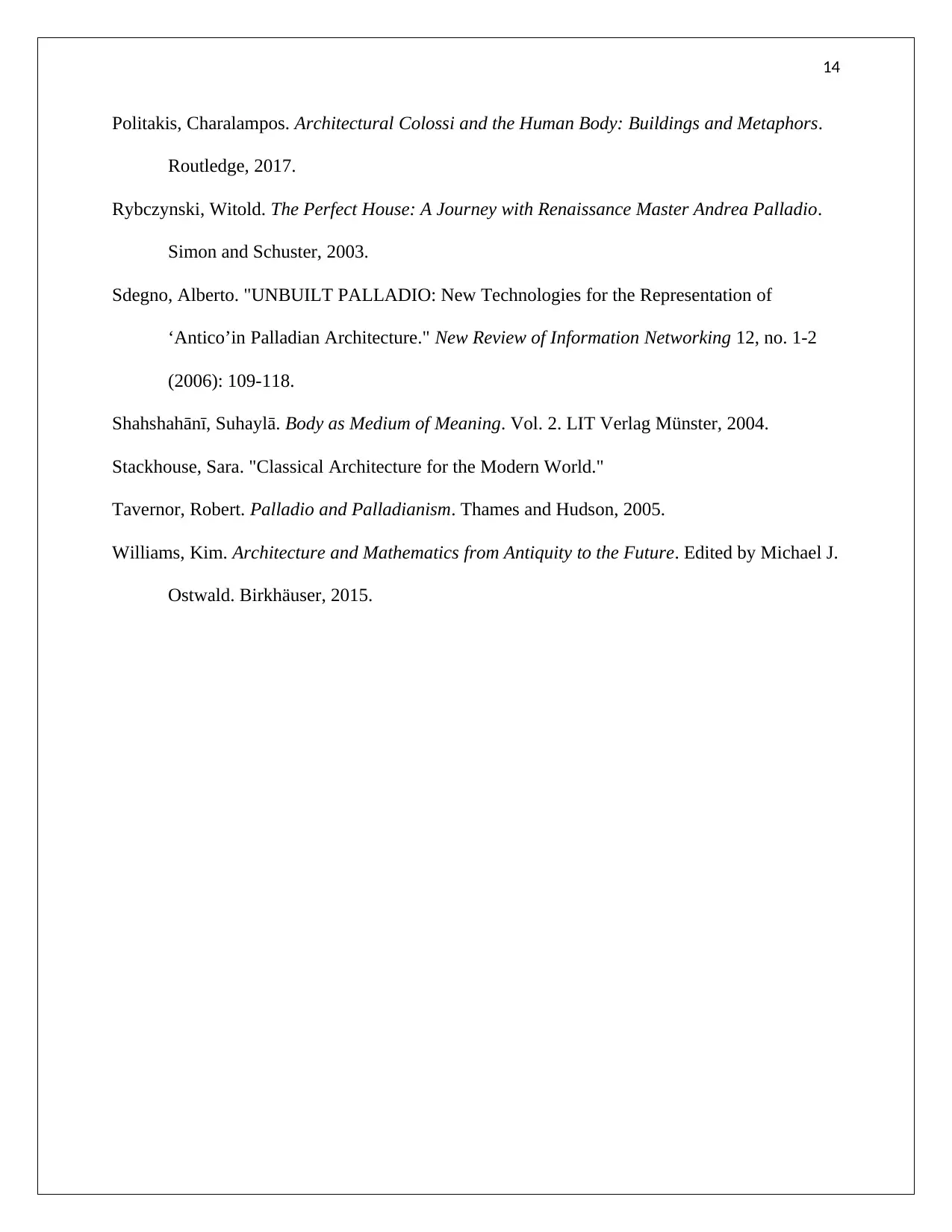
14
Politakis, Charalampos. Architectural Colossi and the Human Body: Buildings and Metaphors.
Routledge, 2017.
Rybczynski, Witold. The Perfect House: A Journey with Renaissance Master Andrea Palladio.
Simon and Schuster, 2003.
Sdegno, Alberto. "UNBUILT PALLADIO: New Technologies for the Representation of
‘Antico’in Palladian Architecture." New Review of Information Networking 12, no. 1-2
(2006): 109-118.
Shahshahānī, Suhaylā. Body as Medium of Meaning. Vol. 2. LIT Verlag Münster, 2004.
Stackhouse, Sara. "Classical Architecture for the Modern World."
Tavernor, Robert. Palladio and Palladianism. Thames and Hudson, 2005.
Williams, Kim. Architecture and Mathematics from Antiquity to the Future. Edited by Michael J.
Ostwald. Birkhäuser, 2015.
Politakis, Charalampos. Architectural Colossi and the Human Body: Buildings and Metaphors.
Routledge, 2017.
Rybczynski, Witold. The Perfect House: A Journey with Renaissance Master Andrea Palladio.
Simon and Schuster, 2003.
Sdegno, Alberto. "UNBUILT PALLADIO: New Technologies for the Representation of
‘Antico’in Palladian Architecture." New Review of Information Networking 12, no. 1-2
(2006): 109-118.
Shahshahānī, Suhaylā. Body as Medium of Meaning. Vol. 2. LIT Verlag Münster, 2004.
Stackhouse, Sara. "Classical Architecture for the Modern World."
Tavernor, Robert. Palladio and Palladianism. Thames and Hudson, 2005.
Williams, Kim. Architecture and Mathematics from Antiquity to the Future. Edited by Michael J.
Ostwald. Birkhäuser, 2015.
1 out of 14
Your All-in-One AI-Powered Toolkit for Academic Success.
+13062052269
info@desklib.com
Available 24*7 on WhatsApp / Email
![[object Object]](/_next/static/media/star-bottom.7253800d.svg)
Unlock your academic potential
© 2024 | Zucol Services PVT LTD | All rights reserved.